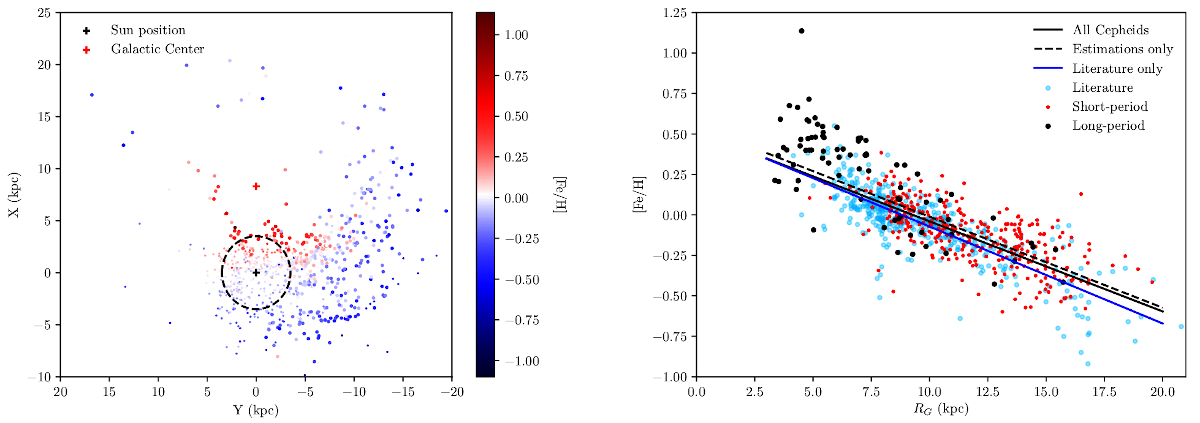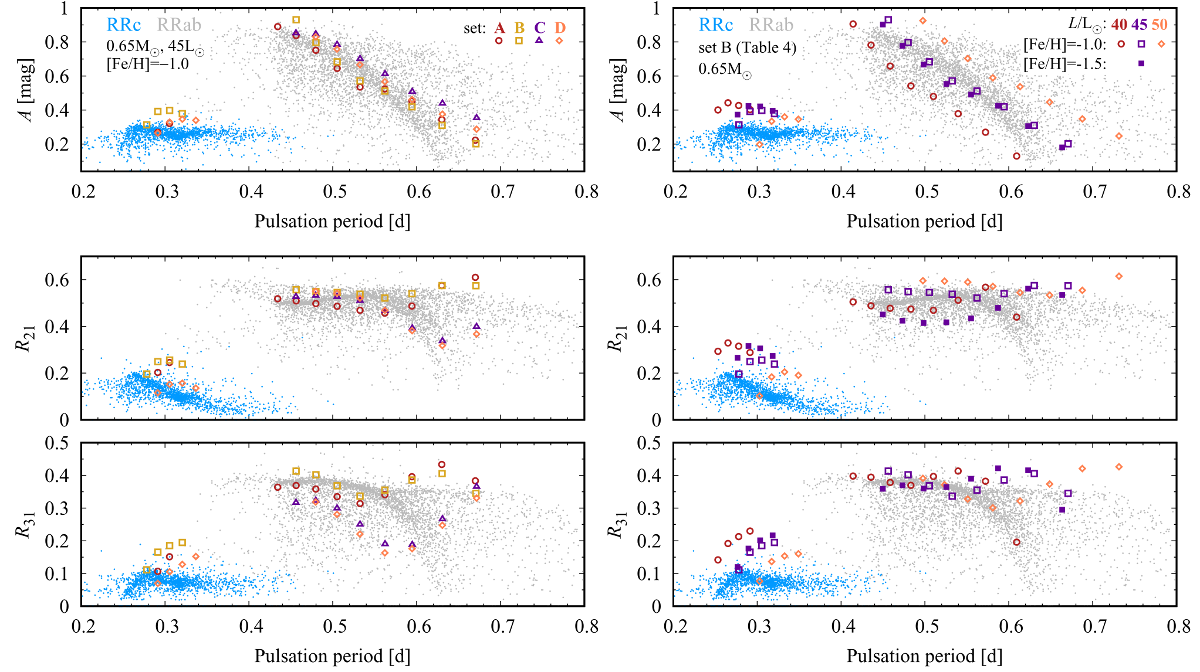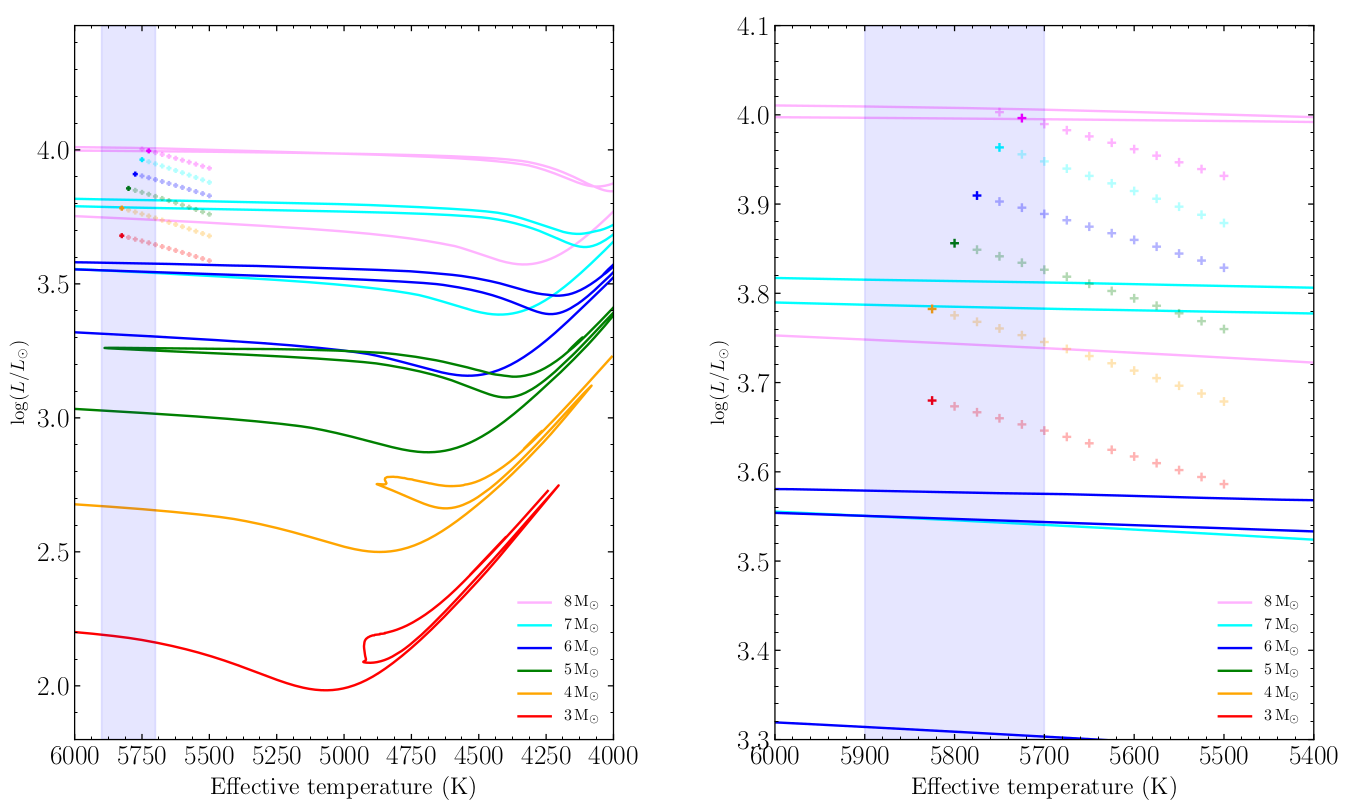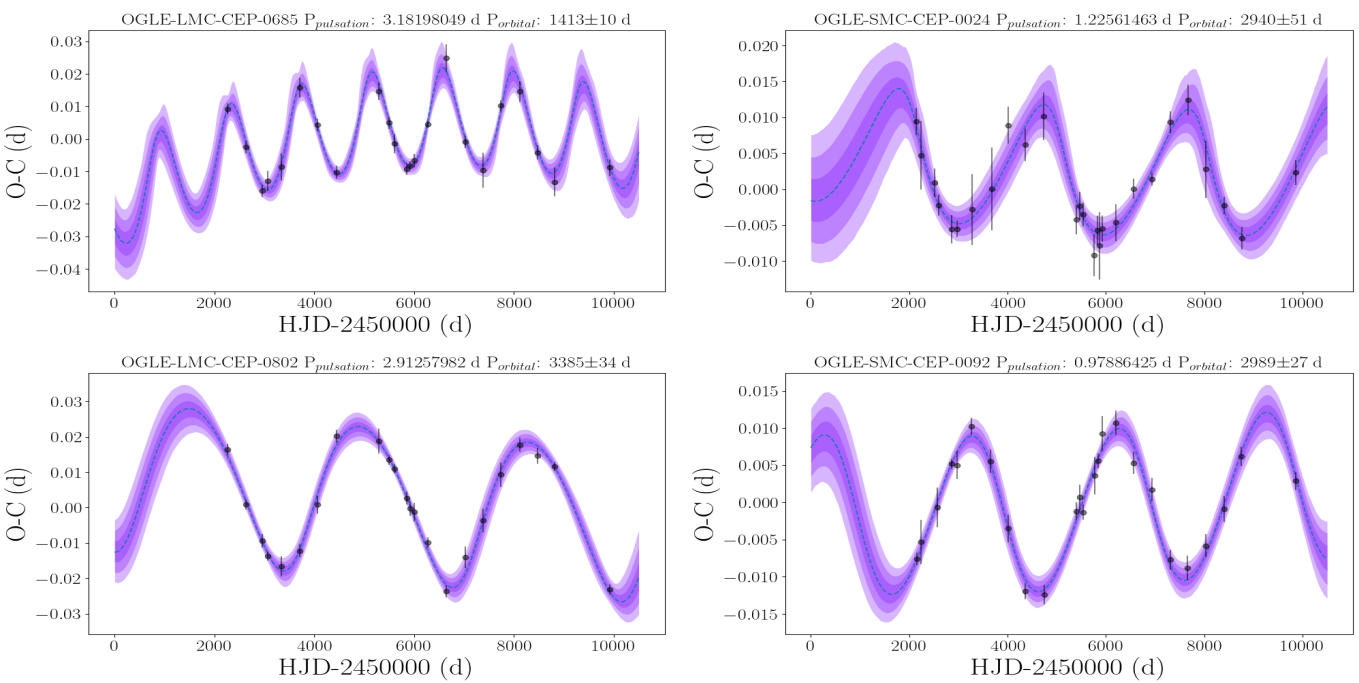Classical Cepheids as testbeds for stellar evolution and pulsation theories
| project | SONATA BIS, 2018/30/E/ST9/00598 |
| funding | Polish National Science Center, NCN |
| PI | Radosław Smolec |
| Co-Is | Vincent Hocde, post-doc (till Sep 2023) |
| Rajeev Singh Rathour, PhD student | |
| Oliwia Ziółkowska, PhD student | |
| dates | 04.2019 - 10.2024 |
Jump to project highlights, refereed publications, conference contributions, and presentations.
Project Highlights
- Photometric metalliciity formulae for classical Cepheids
Estimating the metallicity of classical Cepheids is of prime importance for studying metallicity effects on stellar evolution and the chemical evolution of galaxies, as well as on the period-luminosity relation used on the extragalactic distance scale. Our aim was to establish new empirical relations for estimating the iron content of classical Cepheids for short and long periods based on Fourier parameters from the V- and I-band light curves. The empirical relations in the V and I bands allowed us to derive the mean metallicity of a sample of MW, SMC, and LMC Cepheids that is in agreement with literature values. We also showed that these relations are precise enough to reconstruct the radial metallicity gradients within the Milky Way from OGLE data.
More information: Hocde, V., Smolec, R., Moskalik, P., Ziółkowska, O., Singh Rathour, R. Metallicity estimation of MW, SMC and LMC classical Cepheids from the shape of the V- and I-band light curves; A&A, 671, A157 (2023);
doi:10.1051/0004-6361/202245038.
Left: metallicity distribution of the Milky Way. Right: estimated Cepheid metallicities versus the galactocentric distance for the Milky Way
- RSP - Radial Stellar Pulsation
Modelling of large-amplitude nonlinear pulsation of classical pulsator is challenging, but now new open access tool, Radial Stellar Pulsation (RSP) is available as part of the Modules for Experiments in Stellar Astrophysics (MESA). RSP is based on nonlinear convective pulsation codes developed by R. Smolec as part of PhD thesis, see also Smolec & Moskalik (2008).
More information: B. Paxton, R. Smolec, J. Schwab, A. Gautschy, et al. Modules for Experiments in Stellar Astrophysics (MESA): Pulsating Variable Stars, Rotation, Convective Boundaries, and Energy Conservation, ApJ Suppl. Ser. (2019).
doi:10.3847/1538-4365/ab2241.
The Figure shows a comparison between observed and modelled amplitudes and amplitude ratios for fundamental mode (RRab) and first overtone (RRc) RR Lyrae stars.
- Pulsation Modelling of Y Oph
Y Ophiuchi (Y Oph) is a classical Cepheid with a pulsation period of 17.12 days. This star is reported to be as dim as a Cepheid of about half its pulsation period and it exhibits a low radial velocity and light-curve amplitude. For these reasons, Y Oph is not used to calibrate period-luminosity (PL) relation and its distance remains uncertain.
We find that all pulsation models at high effective temperatures are in remarkable agreement with the observations along the pulsation cycle. This result suggests that the low amplitude of Y Oph may be explained by proximal location to the blue edge of the instability strip (IS). We also find that a pulsational mass of about 7-8 solar masses is consistent with a non-canonical evolutionary model with moderate overshooting, PL relation and Gaia parallax. However, a much lower mass below 5 solar masses is required to match Baade-Wesselink (BW) distance measurements from the literature. We show that the combination of the impact of the CSE on the photometry, together with a projection factor of about 1.5, explains the discrepant distance and luminosity values obtained from BW methods.
More information: Hocde, V., Smolec, R., Moskalik, P., Singh Rathour, R., Ziółkowska, O.; Pulsation modeling of the Cepheid Y Ophiuchi with RSP/MESA. Impact of the circumstellar envelope and a high projection factor on the Baade-Wesselink method; A&A, 683, A233 (2024);
ADS, PDF, arXiv:2312.12046.
The Figure shows HR diagram comparing parameters of MESA-RSP models of Y Oph (crosses) with evolutionary tracks computed with MESA for different stellar masses. These models assume an overshooting parameter fov = 0.02. The vertical blue strip corresponds to the measured value of the mean effective temperature for Y Oph, i.e. Teff = 5800 ± 100K.
- New binary systems with classical Cepheids revealed from light travel time effect
We conduct a systematic search for non-evolutionary period changes to look for Cepheids in likely binary configurations and quantify their incidence rates in the Magellanic Clouds. We collected over a decade's worth time series photometry from the publicly available Optical Gravitational Lensing Experiment (OGLE) with more than 7200 Cepheids altogether from the Large Magellanic Cloud (LMC) and Small Magellanic Cloud (SMC). Our sample contains both fundamental-mode and first-overtone mode Cepheids. Then we calculated the observed minus calculated (O-C) diagrams to reveal the light-travel time effect (LTTE).
We found 52 candidate Cepheid binary systems in the LMC (30 fundamental and 22 first-overtone mode) and 145 in the SMC (85 fundamental and 60 first-overtone mode). The majority of the sample is characterized by orbital periods of 2000-4000 d and eccentricities of 0.2-0.5. Moreover, we report two candidates in each galaxy with the Cepheid likely existing with a giant companion. The incidence rate ratio for SMC to LMC calculated from our sample is in agreement with binary Cepheid population synthesis predictions.
More information: Singh Rathour, R., et al.; Non-evolutionary effects on period change in Magellanic Cepheids. I. New binary systems revealed from light travel time effects; A&A, in press (2024);
arXiv:2403.14039.
The Figure shows exemplary O-C diagrams from our study.
Refereed Publications
- Hocde, V., Smolec, R., Moskalik, P., Singh Rathour, R., Ziółkowska, O.;Pulsation modeling of the Cepheid Y Ophiuchi with RSP/MESA. Impact of the circumstellar envelope and a high projection factor on the Baade-Wesselink method; A&A, 683, A233 (2024); ADS, PDF, arXiv:2312.12046
- Zwintz, K., et al. (incl. Smolec, R.) ;Catalogue of BRITE-Constellation targets. I. Fields 1 to 14 (November 2013-April 2016); A&A, 683, A49 (2024); ADS, PDF, arXiv:2311.18382
- Espinoza-Arancibia, F., Pilecki, B., Pietrzynski, G., Smolec, R., Kervella, P.; Empirical instability strip for classical Cepheids. I. The Large Magellanic Cloud galaxy; A&A, 682, A185 (2024); ADS, PDF, arXiv:2311.15849
- Gladkowski, M., Hajduk, M., Smolec, R., Szczerba, R., Soszynski, I.; Binary central stars of planetary nebulae in the Large Magellanic Cloud ; A&A, 682, A70 (2024); ADS, PDF, arXiv:2311.14556
- Karczmarek, P., Hajdu, G., Pietrzyński, G., Gieren, W., Narloch, W., Smolec, R., Wiktorowicz, G., Belczynski, K., Synthetic Population of Binary Cepheids. II. The Effect of Companion Light on the Extragalactic Distance Scale; ApJ, 950, 182 (2023); ADS, PDF, arXiv:2303.15664
- Hocde, V., Smolec, R., Moskalik, P., Ziółkowska, O., Singh Rathour, R. Metallicity estimation of MW, SMC and LMC classical Cepheids from the shape of the V- and I-band light curves; A&A, 671, A157 (2023); ADS, PDF, arXiv:2301.00229
- Nardetto, N., Gieren, W., Storm, J., Hocde, V., et al., HARPS-N high spectral resolution observations of Cepheids. II. The impact of the surface-brightness color relation on the Baade-Wesselink projection factor of η Aql; A&A, 671, A14 (2023); ADS, PDF, arXiv:2301.09468
- Smolec, R., Ziółkowska, O., Ochalik, M., Ĺniegowska, M., First Overtone Cepheids of the OGLE Magellanic Cloud Collection -- beyond radial modes; MNRAS, 519 4010 (2023); ADS, PDF, arXiv:2212.06732
- Jermyn, A.S., Bauer, E.B., Schwab, J., Farmer, R., Ball, W.H., Bellinger, E.P., Dotter, A., Joyce, M., Marchant, P., Mombarg, J.S.G., Wolf, W.M., Wong, T.L.S., Cinquegrana, G.C., Farrell, E., Smolec, R., Thoul, A., Cantiello, M., Herwig, F., Toloza, O., Bildsten, L., Townsend, R.H.D., Timmes, F.X. Modules for Experiments in Stellar Astrophysics (MESA): Time-Dependent Convection, Energy Conservation, Automatic Differentiation, and Infrastructure; MNRAS, 265, 15 (2023); ADS, PDF, arXiv:2208.03651
- Suchomska, K., Graczyk, D., Gałan, C., Ziółkowska, O., Smolec, R., Pietrzyński, G., Gieren, W., Villanova, S., Górski, M., Thompson, I.B., Wielgórski, P., Zgirski, B., Karczmarek, P., Pilecki, B., Taormina, M., Narloch, W., Hajdu, G., Lewis, M., Kałuszyński, M., Rojas Garcia, G. Evolved eclipsing binary systems in the Galactic bulge: Precise physical and orbital parameters of OGLE-BLG-ECL-305487 and OGLE-BLG-ECL-116218; A&A, 668, A30 (2022); ADS, PDF, arXiv:2210.12413
- Narloch, W., Pietrzyński, G., Gieren, W., Piatti, A.E., Karczmarek, P., Górski, M., Graczyk, D., Smolec, R., Hajdu, G., Suchomska, K., Zgirski, B., Wielgórski, P., Pilecki, B., Taormina, M., Kałuszyński, M., Pych, W., Rojas Garcia, G., Lewis, M.O., Metallicities and ages for star clusters and their surrounding fields in the Large Magellanic Cloud; A&A, 666, A80 (2022); ADS, PDF, arXiv:2207.13153
- Drevon, J., et al. including Hocde, V., Locating dust and molecules in the inner circumstellar environment of R Sculptoris with MATISSE; A&A, 665, A32 (2022); ADS, PDF, arXiv:2208.10845
- Netzel, H., Smolec, R., Modeling of multimode radially pulsating High-Amplitude delta Scuti stars from the OGLE Galactic bulge sample; MNRAS, 515, 4574 (2022); ADS, PDF, arXiv:2207.04210
- Netzel, H., Smolec, R., Asteroseismology of RR Lyrae stars with non-radial modes; MNRAS, 515, 3439 (2022); ADS, PDF, arXiv:2206.12853
- Karczmarek, P., Smolec, R., Hajdu, G., Pietrzyński, G., Gieren, W., Narloch, W., Wiktorowicz, G., Belczynski, K., Synthetic Population of Binary Cepheids. I. The Effect of Metallicity and Initial Parameter Distribution on Characteristics of Cepheids' Companions; ApJ, 930, 65 (2022); ADS, PDF, arXiv:2204.00661
- Chiavassa, A., et al. including Hocde, V., The extended atmosphere and circumstellar environment of the cool evolved star VX Sagittarii as seen by MATISSE; A&A, 658, A185 (2022); ADS, PDF, arXiv:2112.10695
- Wielgórski, P., Pietrzyński, G., Pilecki, B., Gieren, W., Zgirski, B., Górski, M., Hajdu, G., Narloch, W., Karczmarek, P., Smolec, R., Kervella, P., Storm, J., Gallenne, A., Breuval, L., Lewis, M., Kałuszyński, M., Graczyk, D., Pych, W., Suchomska, K., Taormina, M., Rojas Garcia, G., Kotek, A., Chini, R., Pozo Nunez, F., Noroozi, S., Sobrino Figaredo, C., Haas, M., Hodapp, K., Mikołajczyk, P., Kotysz, K., MoĹşdzierski, D., Kołaczek-Szymański, P., An absolute calibration of the near-infrared Period-Luminosity Relations of Type II Cepheids in the Milky Way and in the Large Magellanic Cloud; ApJ, 927, 89 (2022); ADS, PDF, arXiv:2112.12122
- Molnar, L. et al., with Smolec, R., First results on RR Lyrae stars with the TESS space telescope: untangling the connections between mode content, colors and distances; ApJ Suppl. Ser., 258, 8 (2022); ADS, PDF, arXiv:2109.07329
- Rathour, R.S., Smolec, R., Netzel, H., Frequency analysis of OGLE-IV photometry for classical Cepheids in Galactic fields: non-radial modes and modulations; MNRAS, 505, 5412 (2021); ADS, PDF, arXiv:2106.02872
- Plachy, E., et al., including Smolec, R.; TESS Observations of Cepheid Stars: First Light Results ; ApJ Suppl. Ser., 253, 11 (2021); ADS, PDF, arXiv:2012.09709
- Das, S., Kanbur, S., Smolec, R., Bhardwaj, A., Singh, H.P., Rejkuba, M.; A theoretical framework of BL Her stars. I. Effect of metallicity and convection parameters on period-luminosity and period-radius relations; MNRAS, 501, 875 (2021); ADS, PDF, arXiv:2011.11626
- Graczyk, D., Pietrzynski, G., Thompson, I.B., Gieren, W., Zgirski, B., Villanova, S., Gorski, M., Wielgorski, P., Karczmarek, P., Narloch, W., Pilecki, B., Taormina, M., Smolec, R., Suchomska, K., Gallenne, A., Nardetto, N., Storm, J., Kudritzki, R.-P., Kaluszynski, M., Pych, W.; A distance determination to the Small Magellanic Cloud with an accuracy of better than 2 percent based on late-type eclipsing binary stars; ApJ, 904, 13 (2020); ADS, PDF, arXiv:2010.08754
- Soszyński, I., Smolec, R., Udalski, A., Szymański, M.K., Pietrukowicz, P., Skowron, D.M., Skowron, J., Mroz, P., Poleski, R., Kozłowski, S., Iwanek, P., Wrona, M., Gromadzki, M., Ulaczyk, K., Rybicki, K.; OGLE-GAL-ACEP-091 - The First Known Multi-Mode Anomalous Cepheid; ApJ Lett., 901, L25 (2020); ADS, PDF, arXiv:2009.06642
- Savino, A., Koch, A., Prudil, Z., Kunder, A., Smolec, R.; he age of the Milky Way inner stellar spheroid from RR Lyrae population synthesis; A&A, 641, A96 (2020); ADS, PDF, arXiv:2006.12507
- Paxton, B., Smolec, R., Gautschy, A., Bildsten, L., Cantiello, M., Dotter, A., Farmer, R., Goldberg, J.A., Jermyn, A.S., Kanbur, S.M., Marchant, P., Schwab, J., Thoul, A., Townsend, R.H.D., Wolf, W.M., Zhang, M., Timmes, F.X.; Modules for Experiments in Stellar Astrophysics (MESA): Pulsating Variable Stars, Rotation, Convective Boundaries, and Energy Conservation; ApJ Suppl Ser, 243, 10 (2019); ADS, PDF, arXiv:1903.01426
Conference Publications
- Rathour, R.S., Smolec, R., Netzel, H.; Non-radial Modes and Modulation in Galactic Cepheids from OGLE-IV Survey, in Proc. of the Polish Astron. Society (2022), 12, 202; XL Polish Astronomical Society Meeting, Szczecin, Sep 13-17, 2021, www
- Rathour, R.S., Smolec, R.; Period Doubling Effect in Blazkho Modulated RRc Star from OGLE-IV Survey?, in Proc. of the Polish Astron. Society (2022), 12, 209; XL Polish Astronomical Society Meeting, Szczecin, Sep 13-17, 2021, www
- Ziółkowska, O., Suchomska, K., Gałan, C., Smolec, R.; Estimating mass-loss rate in low-mass, evolved eclipsing binaries, in Proc. of the Polish Astron. Society (2022), 12, 213; XL Polish Astronomical Society Meeting, Szczecin, Sep 13-17, 2021, www
- Smolec, R.; Low-amplitude periodicities and modulations in classical pulsators, in Astron. Soc. of the Pacific Conf. Ser. (2020), 529, 287; RRL/Cep 2019 - Frontiers of Classical Pulsators: Theory and Observations, Cloudcroft, Oct 13-18, 2019; www
Presentations
- 2019, Cloudcroft, RRL/Cep 2019 - Frontiers of Classical Pulsators: Theory and Observations, 13-18 Oct;
www
→ Classical pulsators: beyond radial modes - observations and theory; invited talk
